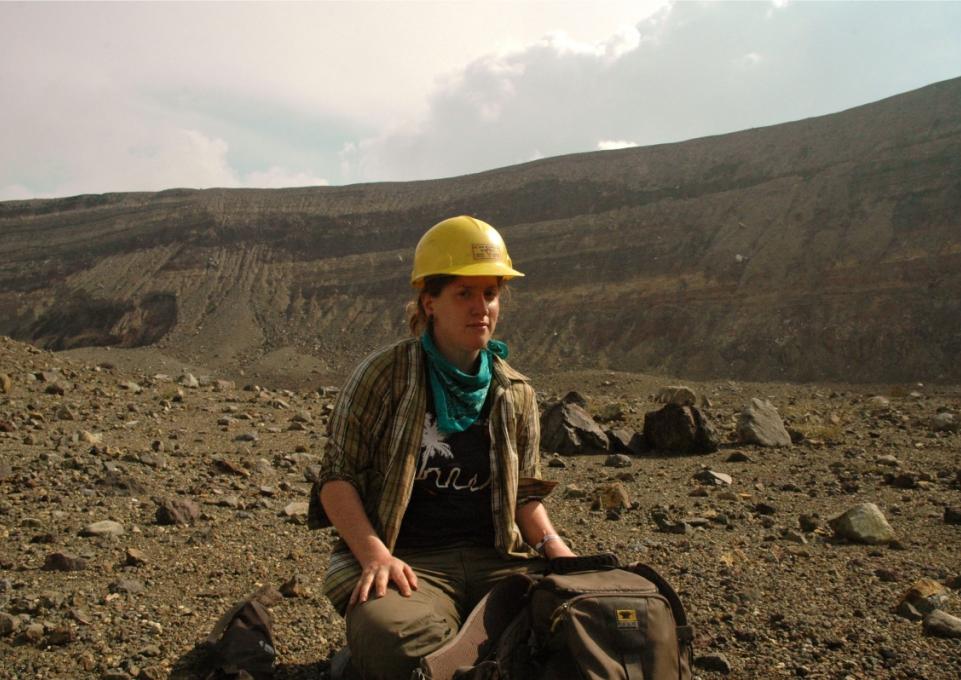
Elisabeth Gallant, class of 2012, is taking part in Posters on the Hill, April 23-24, an event held in Washington, D.C. to “help members of Congress understand the importance of undergraduate research by talking directly with the students.”
The Council for Undergraduate Education (CUR) presents the annual event.
“CUR received over 850 applications to take part in Posters on the Hill and selected just 74 posters to be presented,” said Jill Singer, director of the Undergraduate Research Office (URO) and a past president of CUR.
Gallant, a geology major, will present her research on the largest volcano in El Salvador, Ilamatepec, also known as Santa Ana. Her faculty mentor, Bettina Martinez-Hackert, a volcanologist and assistant professor in the Earth Sciences and Science Education Department, will join her at the Capitol Hill presentation on April 24.
“I think volcanoes are the most exciting phenomenon,” said Gallant. “Even as a kid watching National Geographic and Cosmos on PBS, I found natural hazards—tornadoes, tsunamis, volcanoes—fascinating.”
Several years ago, Gallant took an introductory geology course from Martinez-Hackert and the two developed a good working relationship. With funding from the URO, Gallant took part in a January 2011 field course to El Salvador where she had the opportunity to initiate a research project. Additional funding was awarded to her from the URO to complete her data collection in March 2011. “We even looked at infrared photos of Ilamatepec taken from June 2008 to December 2010,” said Gallant, “to determine if the photos suggested that the volcano is likely to erupt soon, or if the variations in heat output of the volcano were simply seasonal.”
The research group collected samples of volcanic deposits from Ilamatepec’s crater. Awarded an Undergraduate Summer Research Fellowship by the URO, Gallant was able to conduct further research including analyzing the collected ash and other volcanic deposits. The characteristics and composition of these samples were used to determine what kinds of volcanic eruptions likely took place.
“Not all volcanoes erupt the same way,” explained Gallant. “Some are explosive because of high amounts of water that comes out as steam, for example. Others are the kind you see in Hawaii, less explosive and where the flows are like rivers of molten lava. Some, like Mt. Saint Helen’s, can be dangerously explosive. That’s the kind of eruptions that Ilamatepec has.”
It’s important to know how a volcano is most likely to erupt, Gallant explained, because the potential damage and loss of life depends on the kind of eruption. As the abstract for her presentation says, the immediate surroundings of Ilamatepec “include the country’s major economic artery of sugarcane and coffee production, as well as the second and third largest cities in the country.” Nearly half a million people live within 25 kilometers of the volcano, which last erupted in 2005.
“What I really liked about the opportunity to conduct research in El Salvador,” said Gallant, “is that we didn’t look at just one volcano. We looked at El Salvador as a whole, and at the social issues related to living in a natural hazards zone.”
“Her research continued beyond the Undergraduate Summer Fellowship and developed into an honor’s thesis,” said Martinez-Hackert. “The opportunity to spend a summer immersed in research, without worrying about work thanks to funding from the USRF grant from the URO is a unique and amazing opportunity Buffalo State offers to our undergrads. It gives them a definite advantage when applying to graduate schools or jobs. Lis was also able to travel to Australia and to San Francisco with help of Student Travel Awards and present her studies at professional meetings, and that is a priceless experience for the student.”
Gallant, like the other students chosen to take part in Posters on the Hill, has contacted members of Congress to schedule meetings with them on April 24 and to invite them to attend the poster session to be held that evening in the Senate Office Building. One challenge facing the students is explaining the importance of their work to the policymakers who attend the event. “One reason Ilamatepec matters is that we have a lot of trade with El Salvador,” said Gallant, “and American businesses like Starbucks buy a lot of coffee from them. We can also apply what we learn about Ilamatepec here at home.”
Gallant’s goal is to obtain a graduate degree and develop appropriate tools to help people who live in places prone to natural hazards. “For example,” she said, “there was a school built inside a crater in El Salvador. It’s good to understand how the world around us works, but it’s even better to use that knowledge to help people.”
